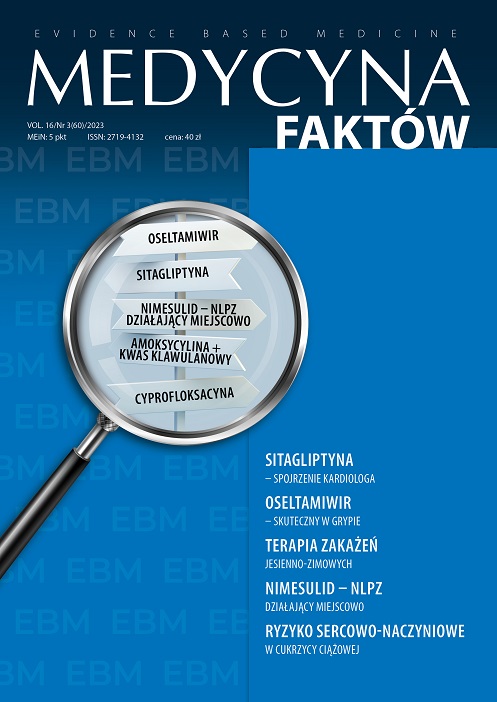Acetylsalicylic acid – selection of drug form Review article
Main Article Content
Abstract
Acetylsalicylic acid is a compound widely used in antiplatelet therapy. Many patients, however, suffer from the problem of resistance to drug or show poor drug tolerance. An alternative and good solution to using higher doses of acetylsalicylic acid or taking proton-pump inhibitor may be the addition of glycine to the immediate release form of acetylsalicylic acid. This approach may prove particularly beneficial among selected patient populations such as the elderly, pregnant women, obese patients, or patients with diabetes.
Article Details
How to Cite
Rudnicka, M. (2023). Acetylsalicylic acid – selection of drug form. Medycyna Faktow (J EBM), 16(3(60), 344-347. https://doi.org/10.24292/01.MF.0323.11
Issue
Section
Articles
Copyright © by Medical Education. All rights reserved.
References
1. Khan H, Kanny O, Syed M et al. Aspirin Resistance in Vascular Disease: A Review Highlighting the Critical Need for Improved Point-of-Care Testing and Personalized Therapy. Int J Mol Sci. 2022; 23: 11317.
2. Du G, Lin Q, Wang J. A brief review on the mechanisms of aspirin resistance. Int J Cardiol. 2016; 220: 21-6.
3. Navaratnam K, Alfirevic A, Alfirevica Z. Low dose aspirin and pregnancy: how important is aspirin resistance? BJOG. 2016; 123: 1481-7.
4. Szałek E. Działanie plejotropowe kwasu acetylosalicylowego. Farm Współ. 2015; 8: 52-8.
5. Połać I, Boryczka K, Bijak M et al. Kwas acetylosalicylowy i jego zastosowanie w profilaktyce chorób u kobiet po menopauzie. Przegl Menopauz. 2011; 1: 45-9.
6. Cox D, Maree AO, Dooley M et al. Effect of enteric coating on antiplatelet activity of low-dose aspirin in healthy volunteers. Stroke. 2006; 37(8): 2153-8.
7. Bhatt DL, Grosser T, Dong JF et al. Enteric Coating and Aspirin Nonresponsiveness in Patients With Type 2 Diabetes Mellitus. J Am Coll Cardiol. 2017; 69: 603-12.
8. Morton M, Kubiak-Balcerewicz K, Sarnowska A et al. Biochemical aspirin resistance in acute stroke patients and its association with clinical factors: a prospective pilot study. Folia Neuropathol. 2021; 59(3): 271-5.
9. Shanmugalingam R, Wang XS, Munch G et al. A pharmacokinetic assessment of optimal dosing, preparation, and chronotherapy of aspirin in pregnancy. Am J Obstet Gynecol. 2019; 221: 255.e1-9.
10. Ren W, Wang W, Guo Y. Analysis of Adverse Reactions of Aspirin in Prophylaxis Medication Based on FAERS Database. Comput Math Methods Med. 2022; 2022: 7882277.
11. de Abajo FJ, Rodríguez LAG. Risk of upper gastrointestinal bleeding and perforation associated with low-dose aspirin as plain and enteric-coated formulations. BMC Clin Pharmacol. 2001; 1: 1.
12. Miilunpohja S, Jyrkkä J, Kärkkäinen JM et al. Discontinuing low-dose acetylsalicylic acid after gastrointestinal bleeding is associated with increased mortality. Scand J Gastroenterol. 2022; 57(5): 618-24.
13. Yang Z, Liao SF. Physiological Effects of Dietary Amino Acids on Gut Health and Functions of Swine. Front Vet Sci. 2019; 6: 169.
14. Kusche W, Paxinos R, Haselmann J et al. Acetylsalicylic acid tablets with glycine improve long-term tolerability in antiplatelet drug therapy: results of a noninterventional trial. Adv Ther. 2003; 20(5): 237-45.
15. Murtaza G, Karim S, Najam-Ul-Haq M et al. Interaction analysis of aspirin witch selective amino acids. Acta Pol Pharm. 2014; 71(1): 139-43.
16. Imenshahidi M, Hossenzadeh H. Effects of glycine on metabolic syndrome components: a review. J Endocrinol Invest. 2022; 45(5): 927-39.
2. Du G, Lin Q, Wang J. A brief review on the mechanisms of aspirin resistance. Int J Cardiol. 2016; 220: 21-6.
3. Navaratnam K, Alfirevic A, Alfirevica Z. Low dose aspirin and pregnancy: how important is aspirin resistance? BJOG. 2016; 123: 1481-7.
4. Szałek E. Działanie plejotropowe kwasu acetylosalicylowego. Farm Współ. 2015; 8: 52-8.
5. Połać I, Boryczka K, Bijak M et al. Kwas acetylosalicylowy i jego zastosowanie w profilaktyce chorób u kobiet po menopauzie. Przegl Menopauz. 2011; 1: 45-9.
6. Cox D, Maree AO, Dooley M et al. Effect of enteric coating on antiplatelet activity of low-dose aspirin in healthy volunteers. Stroke. 2006; 37(8): 2153-8.
7. Bhatt DL, Grosser T, Dong JF et al. Enteric Coating and Aspirin Nonresponsiveness in Patients With Type 2 Diabetes Mellitus. J Am Coll Cardiol. 2017; 69: 603-12.
8. Morton M, Kubiak-Balcerewicz K, Sarnowska A et al. Biochemical aspirin resistance in acute stroke patients and its association with clinical factors: a prospective pilot study. Folia Neuropathol. 2021; 59(3): 271-5.
9. Shanmugalingam R, Wang XS, Munch G et al. A pharmacokinetic assessment of optimal dosing, preparation, and chronotherapy of aspirin in pregnancy. Am J Obstet Gynecol. 2019; 221: 255.e1-9.
10. Ren W, Wang W, Guo Y. Analysis of Adverse Reactions of Aspirin in Prophylaxis Medication Based on FAERS Database. Comput Math Methods Med. 2022; 2022: 7882277.
11. de Abajo FJ, Rodríguez LAG. Risk of upper gastrointestinal bleeding and perforation associated with low-dose aspirin as plain and enteric-coated formulations. BMC Clin Pharmacol. 2001; 1: 1.
12. Miilunpohja S, Jyrkkä J, Kärkkäinen JM et al. Discontinuing low-dose acetylsalicylic acid after gastrointestinal bleeding is associated with increased mortality. Scand J Gastroenterol. 2022; 57(5): 618-24.
13. Yang Z, Liao SF. Physiological Effects of Dietary Amino Acids on Gut Health and Functions of Swine. Front Vet Sci. 2019; 6: 169.
14. Kusche W, Paxinos R, Haselmann J et al. Acetylsalicylic acid tablets with glycine improve long-term tolerability in antiplatelet drug therapy: results of a noninterventional trial. Adv Ther. 2003; 20(5): 237-45.
15. Murtaza G, Karim S, Najam-Ul-Haq M et al. Interaction analysis of aspirin witch selective amino acids. Acta Pol Pharm. 2014; 71(1): 139-43.
16. Imenshahidi M, Hossenzadeh H. Effects of glycine on metabolic syndrome components: a review. J Endocrinol Invest. 2022; 45(5): 927-39.

